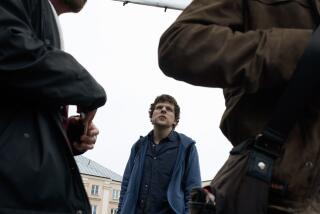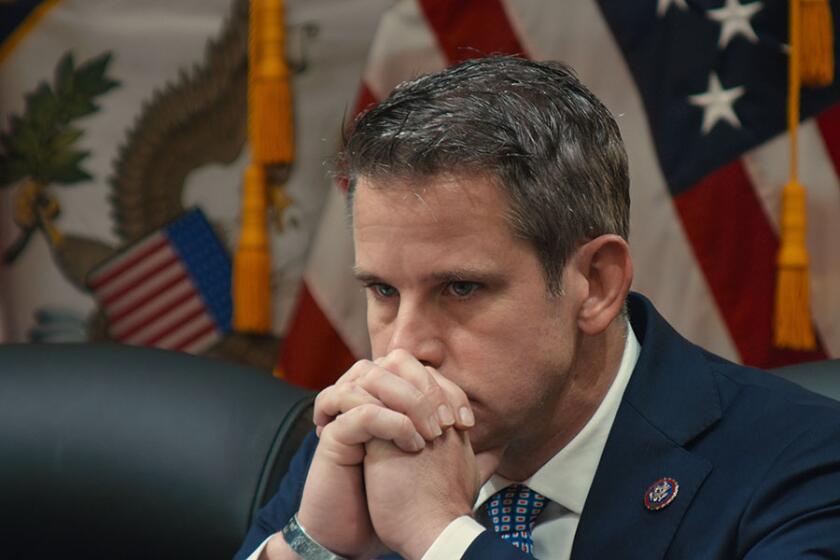Soderbergh takes a space walk with ‘Solaris’
“Solaris” accomplishes many if not quite all of its aims, but what it does most of all is reinforce Steven Soderbergh’s position as Hollywood’s most gifted chameleon, a filmmaker able to operate with elan in all manner of genres.
With the divergent “Ocean’s Eleven,” “Traffic,” “Erin Brockovich” and “Out of Sight” on his recent resume, the writer-director now turns to a remake of the Russian science-fiction classic, directed by celebrated Soviet filmmaker Andrei Tarkovsky in 1972.
Based on a novel by iconoclastic Polish writer Stanislaw Lem and made at a length (two hours and 45 minutes) that enraptured partisans while boring detractors, the original “Solaris” was a challenging, philosophical film that played like “Forbidden Planet” filtered through the dark agonies of the Russian soul.
The new stripped-down 96-minute version, produced by James Cameron’s company, Lightstorm Entertainment, stars George Clooney as a psychologist and Natascha McElhone as his wife, a couple who may or may not be given another chance to experience their love in a space station moored above the strange planet that gives the film its name.
Though it’s a bit more than half as long as its predecessor, the new “Solaris” is in its own way also a brooding, open-ended meditation on themes of love, death, consciousness and identity. Far from a typical studio film in its determination to be elliptical and elusive, it’s an example of sophisticated, challenging filmmaking that stands, despite its noticeable lack of emotional heft, in welcome contrast to the indulgent dead-end experimentation of the director’s previous “Full Frontal.”
As has become habitual with Soderbergh, who serves as his own cinematographer under the Peter Andrews pseudonym and has a hand in the editing as well, “Solaris” is beautifully shot, filled with arresting visuals that intrigue the eye without overwhelming the story.
Working with his longtime production designer Philip Messina (who recently did “8 Mile”), Soderbergh has created an unobtrusive yet convincing futuristic look, sleek, rainy and lived in, that seems to echo “Blade Runner” while carving out territory of its own.
As the director of a focused five-person cast, Soderbergh creates a tight, ensemble feeling that helps the futuristic scenario seem plausible. Yet, though it is adept at creating an inescapably haunting mood, the one effect that turns out to be beyond “Solaris’ ” grasp is making its core story as moving as it needs to be.
The film starts with Clooney as psychologist Chris Kelvin, as darkly brooding as any Russian, living alone and not being happy about it. Then he gets a video message from Gibarian (Ulrich Tukur), a friend in charge of the Solaris space station. Strange things are happening out there, the crew should leave but they don’t want to, and could Kelvin make the trip and negotiate everyone’s safe return.
By the time Kelvin arrives at the station, only two crew members remain alive, and they are not much help. When he asks Snow (Jeremy Davies), a bearded space cadet who looks as spooked as a fugitive moonshiner, what’s happening, he’s told, “I can tell you what’s happening, but I don’t know if that would tell you what’s happening.” Adds Gordon (Viola Davis), “Until it starts happening to you, there’s no point discussing it.”
Almost immediately, it does start happening. In Kelvin’s room with him when he awakes the next morning is his wife, Rheya (McElhone). To all intents and purposes she is a flesh-and-blood human being, but for any number of reasons, this is not possible. What is apparently happening is that the planet itself is causing this to take place for its own unknowable reasons (novelist Lem believed in the impenetrability of alien intelligence), with emotionally devastating results.
At least they’re supposed to be emotionally devastating. Soderbergh in fact attempts to ensure that outcome by showing us the entire trajectory of Kelvin and Rheya’s relationship back on Earth, something the original “Solaris” didn’t do. It’s a good idea, but it’s hamstrung by the film’s overall iciness and by the difficulty Clooney has playing someone who is in complete anguish.
The actor tries hard to capture the correct tone, but his on-screen persona is, not surprisingly, more suited to the irreverence that is his habitual mode to be a match for the much more effective McElhone, who makes genuine emotional connections with her part. Unavoidably, “Solaris” ends up more challenging and intriguing than personally involving, and while these are far from small things, it is only human to hope for more.
*
‘Solaris’
MPAA rating: PG-13 for sexuality/nudity, brief language and thematic elements.
Times guidelines: Shots of unclothed backsides.
George Clooney...Kelvin
Natascha McElhone...Rheya
Viola Davis...Gordon
Jeremy Davies...Snow
Ulrich Tukur...Gibarian
A Lightstorm Entertainment production, released by Twentieth Century Fox. Director Steven Soderbergh. Producers James Cameron, Rae Sanchini, Jon Landau. Executive producer Gregory Jacobs. Screenplay Steven Soderbergh, based on the book by Stanislaw Lem. Cinematographer Peter Andrews. Editor Mary Ann Bernard. Costumes Milena Canonero. Music Cliff Martinez. Production design Philip Messina. Art directors Steve Arnold, Keith P. Cunningham. Set decorator Kristen Toscano Messina. Running time: 1 hour, 36 minutes.
In general release
More to Read
Only good movies
Get the Indie Focus newsletter, Mark Olsen's weekly guide to the world of cinema.
You may occasionally receive promotional content from the Los Angeles Times.











